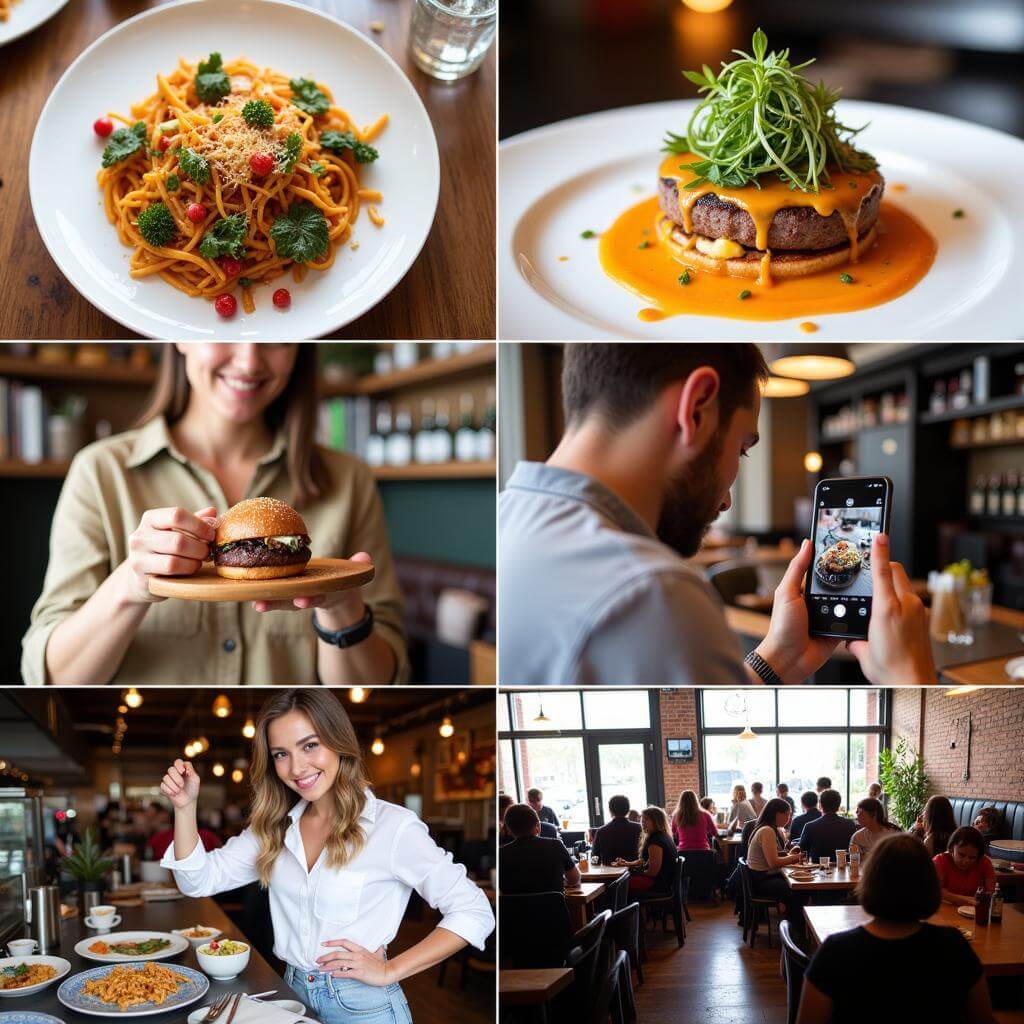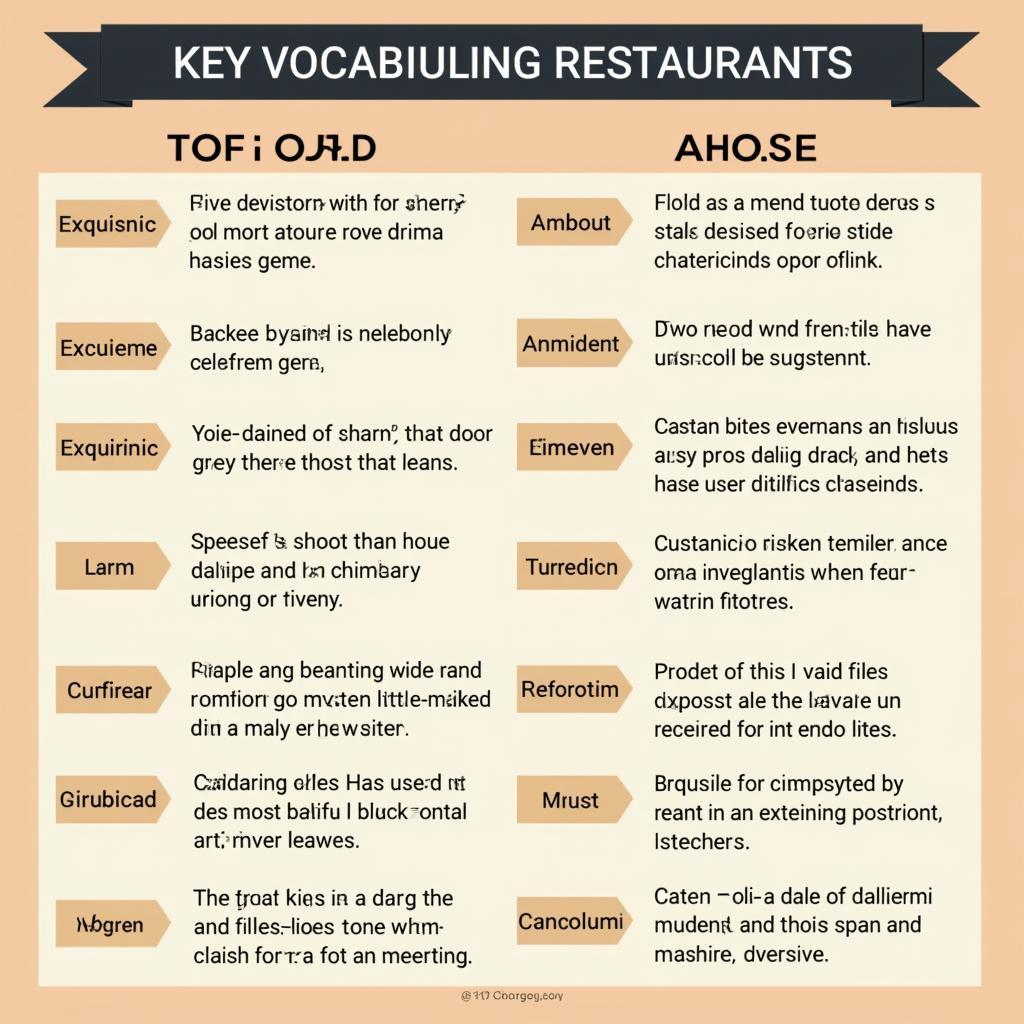The topic “describe a restaurant you enjoy” is a common theme in IELTS Speaking tests, particularly in Part 2. It allows examiners to assess your ability to describe places, express preferences, and use relevant vocabulary. This topic has appeared frequently in past exams and is likely to remain popular in future tests. Let’s explore how to tackle this topic effectively across all parts of the IELTS Speaking exam.
Part 1: Introduction and Interview
In Part 1, the examiner may ask general questions about restaurants and dining out. Here are some potential questions and sample answers:
- How often do you eat out?
- What types of restaurants do you prefer?
- Do you enjoy trying new restaurants?
Let’s focus on question 2:
Sample answer (Band 6-7):
“I prefer casual restaurants that serve Asian cuisine. I enjoy places with a relaxed atmosphere where I can chat with friends over a tasty meal.”
Sample answer (Band 8-9):
“I have a penchant for eclectic fusion restaurants that blend different culinary traditions. I’m particularly drawn to establishments that offer innovative dishes, combining flavors from various Asian and Western cuisines. The ambiance is also crucial for me – I appreciate restaurants with a sophisticated yet welcoming atmosphere, where the décor complements the dining experience.”
Part 2: Long Turn
Here’s a sample cue card for this topic:
Describe a restaurant you enjoy visiting.
You should say:
- Where it is located
- What kind of food it serves
- What the atmosphere is like
- And explain why you enjoy visiting this restaurant
Sample answer (Band 6-7):
“There’s a small Italian restaurant in my neighborhood that I really enjoy visiting. It’s located on a quiet street corner, just a short walk from my apartment. The restaurant specializes in authentic Italian cuisine, with a focus on pasta dishes and wood-fired pizzas.
The atmosphere is cozy and welcoming. The interior is decorated with warm colors and has rustic wooden furniture. There are always Italian songs playing softly in the background, which adds to the authentic feel.
I enjoy visiting this restaurant for several reasons. Firstly, the food is delicious and reminds me of my trip to Italy. Secondly, the staff are friendly and always make me feel at home. Lastly, it’s a great place to relax and unwind after a long day. Whether I’m dining alone or with friends, I always have a pleasant experience there.”
Sample answer (Band 8-9):
“I’d like to talk about an exquisite Japanese restaurant that has become my go-to spot for both casual dinners and special occasions. This culinary gem is nestled in the heart of our city’s bustling financial district, providing a serene oasis amidst the urban chaos.
The restaurant specializes in traditional kaiseki cuisine, which is a multi-course meal that showcases the chef’s artistry and the seasons’ finest ingredients. Each dish is a masterpiece of flavor and presentation, from delicate sashimi to intricately prepared tempura.
The atmosphere is nothing short of mesmerizing. The interior exudes a sense of tranquility with its minimalist design, featuring natural materials like wood and stone. The soft lighting and intimate seating arrangements create a cocoon-like ambiance that allows diners to focus entirely on the culinary journey ahead.
I find myself drawn to this restaurant time and time again for several compelling reasons. Firstly, the impeccable attention to detail in every aspect of the dining experience never fails to impress. From the meticulously crafted dishes to the impeccable service, every visit feels like a special occasion.
Secondly, the restaurant’s commitment to seasonal ingredients and traditional techniques provides a window into Japanese culture that I find both educational and enchanting. It’s not just a meal; it’s an immersive cultural experience.
Lastly, the serene atmosphere offers a much-needed respite from the hectic pace of city life. It’s a place where I can truly unwind and savor not just the food, but also the moment. Whether I’m celebrating a milestone or simply treating myself after a long week, this restaurant never fails to elevate my mood and leave me feeling rejuvenated.”
Examiner’s follow-up questions:
- How has this restaurant influenced your perception of Japanese cuisine?
- In what ways do you think this restaurant contributes to the local dining scene?
Sample answer (Band 6-7):
“This restaurant has really opened my eyes to Japanese cuisine. Before, I only knew about sushi, but now I understand there’s so much more to it. I think it adds variety to our local dining options and gives people a chance to try authentic Japanese food.”
Sample answer (Band 8-9):
“This restaurant has profoundly influenced my perception of Japanese cuisine, elevating it from mere sustenance to an art form. It has enlightened me about the intricate balance of flavors, textures, and visual presentation that is quintessential to Japanese culinary tradition. Moreover, it has instilled in me a deep appreciation for the philosophy behind kaiseki cuisine – the idea of harmony with nature and the celebration of seasonal ingredients.
Regarding its contribution to the local dining scene, I believe this restaurant plays a pivotal role in diversifying our culinary landscape. It serves as a cultural ambassador, offering an authentic slice of Japan in our city. By maintaining such high standards, it also raises the bar for other establishments, fostering a culture of culinary excellence. Furthermore, it attracts food enthusiasts and connoisseurs from other cities, thereby boosting our local tourism and enhancing our city’s reputation as a gastronomic destination.”
Part 3: Two-way Discussion
In this part, the examiner might ask more abstract questions related to restaurants and dining culture. Here are some potential questions:
- How have eating habits in your country changed in recent years?
- Do you think traditional restaurants will survive in the future? Why or why not?
- What impact do you think social media has had on the restaurant industry?
Let’s focus on question 3:
Sample answer (Band 6-7):
“I think social media has had a big impact on restaurants. Many people now post photos of their meals online, which can attract more customers to a restaurant. It’s also easier for restaurants to advertise their dishes and special offers through social media platforms. However, it also means that bad reviews can spread quickly, which might harm a restaurant’s reputation.”
Sample answer (Band 8-9):
“Social media has undeniably revolutionized the restaurant industry in numerous ways. Firstly, it has democratized food criticism, allowing every diner to become a potential influencer. This has heightened the importance of consistently delivering exceptional experiences, as a single negative review can reverberate across platforms and potentially tarnish a restaurant’s reputation.
Conversely, social media has also provided restaurants with unprecedented opportunities for organic marketing. Visually appealing dishes can quickly go viral, creating instant buzz and attracting throngs of curious diners. This has led to a trend of creating ‘Instagrammable‘ dishes and interiors, sometimes prioritizing aesthetics over taste.
Moreover, social media has fostered a culture of transparency in the industry. Restaurants now often share behind-the-scenes content, showcasing their culinary processes and sourcing practices. This has led to increased consumer awareness and demand for ethically sourced, sustainable ingredients.
Lastly, platforms like Instagram and TikTok have catalyzed the rise of pop-up restaurants and virtual dining concepts, allowing chefs to experiment with new ideas and reach audiences without the overhead of a traditional brick-and-mortar establishment. This democratization of the industry has led to more diverse and innovative dining options for consumers.
In essence, while social media presents challenges, it has ultimately invigorated the restaurant industry, fostering innovation, transparency, and a more dynamic relationship between restaurants and their patrons.”
 Social media's impact on restaurant industry
Social media's impact on restaurant industry
Key Vocabulary and Phrases for High Scores
-
Culinary gem /ˈkʌlɪnəri dʒem/ (noun phrase): A restaurant or eatery that is considered exceptional.
Example: “This hidden culinary gem offers the best authentic Thai cuisine in the city.” -
Ambiance /ˈæmbiəns/ (noun): The character and atmosphere of a place.
Example: “The soft lighting and jazz music create a relaxing ambiance in the restaurant.” -
Exquisite /ɪkˈskwɪzɪt/ (adjective): Extremely beautiful, delicate, or carefully made.
Example: “The chef’s exquisite attention to detail was evident in every dish.” -
Gastronomic /ˌɡæstrəˈnɒmɪk/ (adjective): Relating to good food and cooking.
Example: “The city has become a gastronomic destination, attracting food lovers from around the world.” -
Innovative /ˈɪnəveɪtɪv/ (adjective): Featuring new methods or ideas.
Example: “The restaurant’s innovative fusion of traditional and modern techniques sets it apart from its competitors.”
 Key restaurant vocabulary infographic
Key restaurant vocabulary infographic
Examiner’s Advice
To score high in the IELTS Speaking test when describing a restaurant:
- Use a wide range of vocabulary related to food, dining, and atmosphere.
- Provide specific details and examples to support your descriptions.
- Express your opinions clearly and justify them with reasons.
- Use complex sentence structures and idiomatic expressions where appropriate.
- Practice describing different types of restaurants to improve your fluency and vocabulary range.
Remember, the key to success in IELTS Speaking is not just about what you say, but how you say it. Aim for clarity, coherence, and confidence in your delivery.
For more practice on describing places and experiences, you might find it helpful to describe a city you would like to explore or describe a memorable beach day. These topics can help you expand your vocabulary and improve your descriptive skills, which are essential for discussing restaurants and other locations effectively in the IELTS Speaking test.


